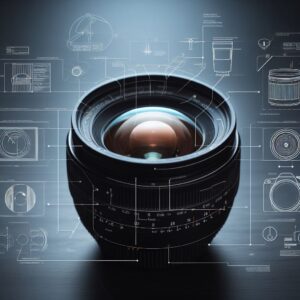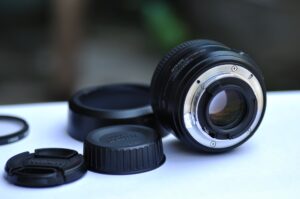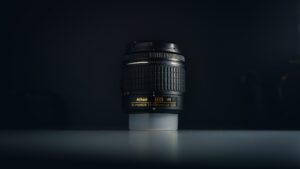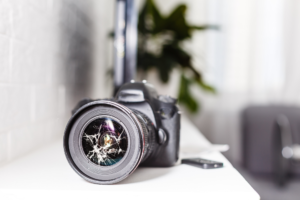When you ask, “What camera lens do I need?“, the answer largely depends on your photography goals. However, for most beginners, a standard zoom lens often suffices.
In this guide, we’ll look into the importance of choosing the right lens, especially for those just starting out.
By the end, you’ll have a clearer picture (pun intended!) of the lens world and be better equipped to make an informed decision.
The Ideal Lens for Most Beginner Photographers
For many budding photographers, a standard zoom lens (typically in the range of 24-70mm) is the go-to choice. Here’s why:
- Versatility: It’s like having multiple lenses in one. You can capture wide landscapes, zoom in on distant subjects, or snap a portrait, all without changing the lens.
- Cost-effectiveness: Instead of investing in multiple prime lenses, a standard zoom offers a range of focal lengths for the price of one lens.
- Beginner-friendliness: With a zoom lens, you can experiment with different compositions and perspectives, making it a great learning tool.
For those interested in the nuances of lens compatibility, are camera lenses universal? offers a deeper dive.
Understanding the Basics
What Does a Lens Do?
At its core, a camera lens gathers and focuses light onto the camera sensor, creating an image. Think of it as the eye of your camera.
The quality and type of lens you use can significantly influence the clarity, color, and overall quality of your photographs.
Focal Length Explained
The focal length of a lens, measured in millimeters (mm), determines how “zoomed in” your photos appear.
Here’s a simple breakdown:
- Wide-angle (less than 35mm): Captures a broader scene. Ideal for landscapes and architecture.
- Standard (35mm – 70mm): Mimics the human eye’s perspective. Suitable for everyday photography.
- Telephoto (more than 70mm): Magnifies distant subjects. Perfect for wildlife or sports photography.
Aperture and Its Influence
Aperture refers to the opening in the lens that lets light in. It’s denoted by an “f-number” (e.g., f/1.8, f/3.5). A smaller f-number means a larger aperture and vice versa.
Here’s why it matters:
- Depth of Field: A larger aperture (small f-number) creates a shallow depth of field, blurring the background and making the subject stand out. This effect is often used in portrait photography.
- Low-light Performance: Lenses with larger apertures can gather more light, making them ideal for low-light situations like indoor events or nighttime photography.
The lens you choose can either elevate or limit your photography. As you continue reading, you’ll gain more insights to help you make the best choice for your needs.
Exploring Different Lens Types
Photography is an art, and like any artist, you need the right tools to bring your vision to life.
Lenses are essential tools in this regard. Let’s dive into the various lens types and understand their unique attributes.
The Versatility of Normal Lenses
Normal lenses, often referred to as “standard” lenses, have a focal length roughly equivalent to the human eye’s view, typically around 50mm.
This makes them incredibly versatile:
- Natural Perspective: They reproduce scenes in a way that feels familiar and intuitive.
- Lightweight: Often more compact than extreme wide-angle or telephoto lenses, making them great for everyday use.
- Affordability: Generally, they’re more affordable than specialized lenses.
Dramatic Shots with Wide Angle Lenses
Wide-angle lenses have a focal length less than 35mm.
They’re the go-to for capturing expansive scenes:
- Broad Field of View: Ideal for landscapes, architecture, and interior photography.
- Exaggerated Perspective: They can make foreground objects appear larger relative to the background, adding drama to a shot.
For those who love capturing vast landscapes or city skylines, the wide-angle lens is a must-have in your kit.
Capturing Distance: The Power of Telephoto Lenses
Telephoto lenses, with a focal length greater than 70mm, are all about bringing distant subjects closer:
- Magnification: Capture far-off subjects, like birds or athletes, in great detail.
- Shallow Depth of Field: They can create a beautiful blur in the background, making the subject pop.
- Compression: They can make objects appear closer together than they actually are, which can be used creatively in compositions.
Whether you’re into wildlife photography or sports events, a telephoto lens is indispensable.
Specialty Lenses and Their Unique Features
Beyond the standard categories, there are specialty lenses designed for specific tasks:
- Macro Lenses: For extreme close-ups, like insects or flower details.
- Tilt-Shift Lenses: Allow for perspective control, popular in architectural photography.
- Fisheye Lenses: Produce a super wide-angle, almost hemispherical image.
Each of these lenses serves a unique purpose, allowing photographers to experiment and get creative with their shots.
Prime vs. Zoom Lenses: A Simple Comparison for Beginners
| Feature | Prime Lens | Zoom Lens |
|---|---|---|
| Focal Length | Fixed (e.g., 50mm) | Variable (e.g., 24-70mm) |
| Aperture | Often larger (e.g., f/1.8) | Can vary, some have fixed apertures |
| Image Quality | Generally sharper | Quality can vary, but modern zooms are excellent |
| Price | Can be more affordable | Range widely based on features and quality |
While prime lenses offer sharpness and often better low-light performance, zoom lenses provide flexibility in composing shots.
Choosing the Right Lens for Your Needs
Your choice of lens can significantly influence the outcome of your photos. Let’s explore which lenses are best suited for various photography styles.
Portrait Photography
For portraits, you’d want a lens that can blur the background, making the subject stand out.
A prime lens with a focal length between 50mm to 85mm and a large aperture (like f/1.8) is ideal.
This setup ensures your subject remains sharp while the background gets a beautiful bokeh effect.
Landscape Photography
For landscapes, a wide-angle lens (like 16-35mm) is preferred.
It captures vast scenes, from mountain ranges to cityscapes, in all their glory.
The broader perspective ensures you don’t miss any detail.
Wildlife and Sports Photography
Capturing a bird in flight or an athlete in action requires a telephoto lens.
With focal lengths upwards of 200mm, they allow you to get close to the action, even if you’re physically far away.
Macro and Close-Up Photography
If you’re fascinated by the minute details of insects, flowers, or even jewelry, a macro lens is your best friend.
It allows for extreme close-ups, revealing details often invisible to the naked eye.
Street and Documentary Photography
For street photography, a compact and fast lens is essential.
A standard prime lens, like a 35mm or 50mm with a large aperture, allows for quick shots without drawing too much attention.
Choosing the right lens is a journey of understanding your photographic interests and matching them with the right tools.
As you grow in your photography journey, you’ll find that experimenting with different lenses can open up new creative avenues.
Key Considerations for Beginners
Embarking on your photography journey is thrilling, but it’s essential to make informed decisions, especially when investing in lenses.
Here are some crucial considerations every beginner should be aware of:
Compatibility with Your Camera
Before splurging on a new lens, ensure it’s compatible with your camera body. Not all lenses fit all cameras.
Factors like the lens mount, sensor size, and even the brand play a role in compatibility.
If you’re wondering, are camera lenses universal?, the short answer is no. However, the linked article provides a more in-depth exploration of this topic.
Price Considerations
Lenses can range from affordable to exorbitantly priced. As a beginner, it’s essential to strike a balance between quality and cost.
While high-end lenses offer superior optics and build, there are budget-friendly options that deliver commendable performance.
If you’re on a tight budget, consider exploring the used lens market. But before you do, check out this guide on whether you should buy used camera lenses to make an informed decision.
Understanding OEM and Third-Party Lenses
When shopping for lenses, you’ll come across terms like OEM (Original Equipment Manufacturer) and third-party lenses.
Here’s a brief overview:
- OEM Lenses: Produced by the same brand as your camera (e.g., Canon lenses for Canon cameras). They often have optimized performance for the specific camera brand and come with a premium price tag.
- Third-Party Lenses: Manufactured by companies that produce lenses for various camera brands (e.g., Sigma, Tamron). They can offer comparable quality at a more affordable price, but it’s essential to read reviews and ensure they’re compatible with your camera.
Basic Lens Features to Know
While the type of lens (wide-angle, telephoto, macro) defines its primary use, other features can significantly impact your photography experience.
Image Stabilization
Image Stabilization (IS) is a feature that reduces the effects of camera shake, especially at slower shutter speeds or longer focal lengths. It’s particularly beneficial for:
- Handheld Photography: When you’re shooting without a tripod.
- Low Light Conditions: Where you need slower shutter speeds to capture enough light.
- Telephoto Shooting: As longer focal lengths amplify the effects of camera shake.
Macro Lenses
Macro lenses allow you to focus extremely close to subjects, revealing intricate details.
They’re perfect for:
- Nature Photography: Capturing details of insects, flowers, and more.
- Product Photography: Showcasing product features up close.
A true macro lens offers a 1:1 magnification ratio, meaning the subject appears life-size on the camera’s sensor.
Lenses for Different Sensor Sizes
Cameras come with various sensor sizes, like full-frame, APS-C, and micro four-thirds.
The sensor size impacts the effective focal length of a lens.
For a deeper understanding of how lenses and sensors interact, explore how camera lenses work.
Care and Maintenance for Beginners
Investing in a camera lens is just the beginning. To ensure its longevity and optimal performance, proper care and maintenance are paramount.
Here’s a beginner’s guide to keeping your lens in top shape.
Protecting Your Lens
Your lens, being the eye of your camera, is susceptible to scratches, dust, and other potential damages.
Here’s how to protect it:
- Lens Caps: Always cap your lens when not in use. It’s a simple yet effective way to prevent scratches and dust accumulation.
- Lens Protectors: These are clear filters that screw onto the front of your lens. But are camera lens protectors necessary? While they offer an added layer of protection, they might affect image quality. It’s a trade-off worth considering.
- Weather Conditions: Not all lenses can withstand rain or snow. Before venturing out, it’s essential to know: Are camera lenses waterproof? Some are weather-sealed, but it’s always good to be cautious.
Cleaning and Maintenance Basics
Dust, fingerprints, and smudges are inevitable.
Here’s how to keep your lens clean:
- Use a Lens Blower: Before wiping the lens, use a blower to remove loose dust particles. This prevents scratches during the cleaning process.
- Lens Cleaning Solution and Microfiber Cloth: For smudges and fingerprints, a few drops of a lens cleaning solution on a microfiber cloth does the trick. Remember, always spray the cloth, not the lens directly.
- Regular Check-ups: Periodically inspect your lens for fungus or haze, especially if stored in humid conditions. If you’re unsure about cleaning, how do you clean a camera lens? provides a detailed guide.
Getting Started with Your New Lens
Congratulations on your new lens! Here’s how to make the most of it:
- Read the Manual: It might sound tedious, but the manual often contains valuable insights specific to your lens.
- Practice: Familiarize yourself with the lens. Take shots at different apertures, focal lengths, and lighting conditions.
- Experiment: Don’t be afraid to step out of your comfort zone. Try different compositions, perspectives, and subjects. Photography is as much about creativity as it is about technique.
FAQs
How can I determine the right camera lens for me?
Identifying the right camera lens depends on your photography style and subjects. Consider your primary subjects, lighting conditions, and desired effects to make an informed choice.
Which lens is suitable for specific photography types?
Different lenses cater to various photography styles. For instance, wide-angle lenses are ideal for landscapes, while telephoto lenses excel in wildlife photography.
Which trio of lenses is essential for photographers?
Every photographer should ideally have a standard lens (around 50mm), a wide-angle lens (less than 35mm), and a telephoto lens (more than 70mm) in their kit.
Why is a 50mm lens often recommended?
A 50mm lens, often termed the “nifty fifty,” offers a perspective similar to the human eye, making it versatile for portraits, landscapes, and everyday shots.
What’s the primary use of a 300mm lens?
A 300mm lens is a telephoto lens, primarily used for capturing distant subjects, such as wildlife or sports events, in detail.
What advantages does a 35mm lens offer?
A 35mm lens provides a slightly wide perspective, making it perfect for street photography, environmental portraits, and general-use photography.
What factors should I weigh when purchasing a lens?
When buying a lens, consider its focal length, aperture, compatibility with your camera, and, of course, your budget.
What’s the specialty of a 55mm lens?
A 55mm lens is close to a standard lens, offering a natural perspective suitable for portraits, landscapes, and general photography.
Is the lens more crucial than the camera body?
While both are essential, the lens often plays a more significant role in image quality, clarity, and artistic effects than the camera body.
Can any lens fit any camera model?
No, lens compatibility depends on the camera’s mount and sensor size. It’s vital to ensure a lens fits your camera model before purchasing.
How many lenses are ideal for a photographer’s collection?
The number of lenses one should own varies based on individual needs. However, having a standard, wide-angle, and telephoto lens is a good starting point.
Should I prioritize upgrading my camera or my lens?
Often, upgrading your lens can have a more noticeable impact on image quality and artistic capabilities than upgrading the camera body.
Conclusion
Embarking on your photography journey is exciting!
With the right lens and knowledge, the world becomes your canvas.
While technicalities are essential, the heart of photography lies in experimenting with capturing moments and telling stories.


![You are currently viewing What Camera Lens Do I Need? A Comprehensive Guide for Beginners [2023]](https://photographyexplorer.com/wp-content/uploads/2023/08/what-camera-lens-do-I-need.jpg)



![Read more about the article Lens Care 101: How Do You Clean a Camera Lens? [2023]](https://photographyexplorer.com/wp-content/uploads/2023/08/How-Do-You-Clean-a-Camera-Lens-300x200.jpg)


Pingback: The Complete Guide on How Camera Lenses Are Made - Photography Explorer
Pingback: Canon vs Nikon vs Sony vs Fujifilm: Which Brand is Best? - Photography Explorer
Pingback: The Best Lens for Moon Photography in 2023 - Photography Explorer